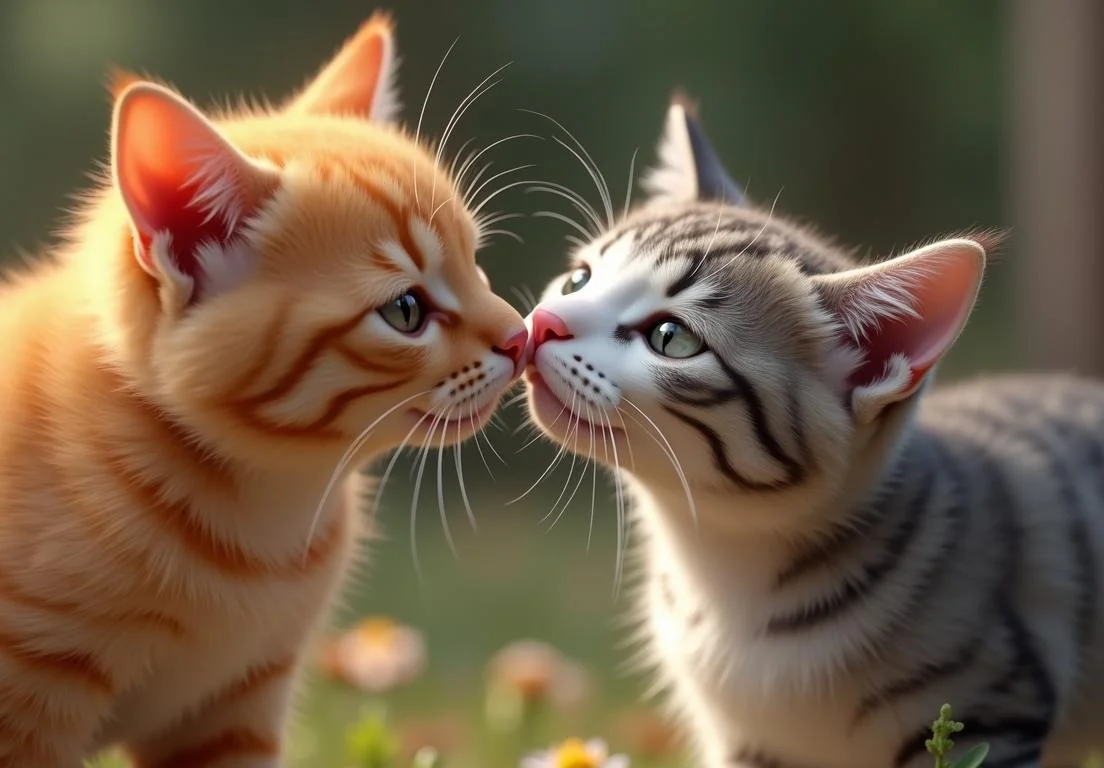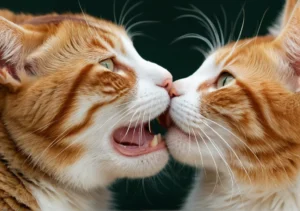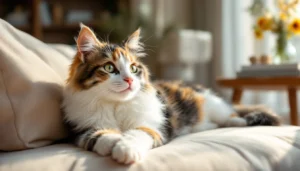Cats have a way of creeping into our hearts, often with their subtle purrs and gentle nuzzles. Ever notice how they rub up against you at the most unexpected moments? It’s not just a quirky habit; there’s meaning behind their affectionate behavior.
Cats rub against you primarily to mark their territory with scent, seeking comfort, affection, or to initiate play. But there’s a lot more behind this endearing behavior! What other reasons might your feline friend be sharing with you? Keep reading for a deeper look into the secrets of cat communication.

1 Why Do Cats Mark Their Territory?
Cats have a unique way of claiming their space, and it often boils down to their scent glands. These glands, located around their face, paws, and tail, release pheromones that convey messages to other cats. When your cat rubs against you, they’re not just seeking your attention; they’re marking you as part of their territory. It’s a blend of reassurance and comfort, as they strengthen their bond with you.
This behavior is particularly notable in multi-pet households or environments where they sense competition. By rubbing against you, they assert their ownership and create a “safe haven” feeling in their shared space. So, next time your feline friend brushes against your leg, remember—it’s their way of saying, “You’re mine, and I’m proud of it!”
2 What Does Affection Look Like?
Cats show their affection in a variety of ways that go beyond cuddles and purring. Rubbing against you is a significant gesture, expressing trust and closeness. When your cat leans into you, they’re not just seeking comfort; they’re actively communicating their love. This behavior can signal various emotional states, from relaxed contentment to a desire for playtime or attention.
Affectionate behaviors often include:
- Slow blinking: This is essentially a feline way of saying, “I trust you.”
- Head butting: A gentle nudge can indicate that your cat considers you part of their family.
- Following you around: They just want to be where you are, reflecting their attachment.
Understanding these nuances can deepen your bond with your cat, ensuring you recognize when they’re feeling particularly affectionate or simply want some quality interaction. Noticing these subtleties adds a rich layer to your relationship with your feline companion, fostering even more love and connection.
3 How Do Cats Communicate Through Rubbing?
Rubbing is a core part of how cats express themselves. When your feline friend bumps against you, they’re not just seeking warmth; they’re also sending complex signals. This behavior is laden with meaning, often signifying affection, ownership, or simply a need for comfort.
Cats have scent glands located on their faces, paws, and tails, and when they rub against you, they’re marking their territory with their unique scent. This is a way for them to stake a claim and let other pets or even people know you’re “theirs.”
Moreover, rubbing can indicate that your cat is feeling relaxed and confident in its environment. This behavior can be particularly prominent in new surroundings. Think of it as an expressive way for them to say, “I trust you” and “I feel safe here.” Additionally, some cats might engage in this behavior when they’re stressed or anxious, trying to garner reassurance and connection from you.
Recognizing these nuances will help you understand your cat’s emotional state better. Next time they rub against you, take it as a compliment; they’re sharing their world with you in their own unique way.
4 Are They Seeking Attention?
Absolutely! Cats are notorious for their selective attention, but don’t be fooled. When they rub up against you, it’s often their clever way of signaling they want something—be it playtime, cuddles, or a bit of both.
Here’s how to recognize their motives:
- Head-butting: This classic move often means your cat is feeling playful and wants you to join in on the fun.
- Belly rub requests: If they roll over after rubbing, they’re inviting you to scratch that belly, a sign of trust and affection.
- Pacing or meowing: If they’re rubbing against your legs while vocalizing, they’re more insistent about needing your attention.
Additionally, this behavior isn’t just about immediate affection. Cats are also social creatures that thrive on routine interactions. If you notice it happening frequently, it can be a way for them to maintain connection and reinforce your bond. Don’t hesitate to engage; it’s a wonderful opportunity for connection that enriches both your lives. You might even find that your cat has a few tricks up its sleeve that add some fun to your day!
5 What Role Does Your Cat’s Mood Play?
Cats are incredibly emotional creatures, and their mood significantly influences how they interact with us. When your feline friend rubs against you, it can be a reflection of their feelings at that moment. For instance, if they’re feeling relaxed and happy, you might see more frequent and gentle rubs. This is their way of expressing love and contentment.
Conversely, if your cat seems a bit stressed or anxious, rubbing might serve as a form of self-soothing or a way to seek comfort from you. In these moments, it’s not just about affection; it’s more about sharing their tension and looking for reassurance. Additionally, when a cat is feeling playful or curious, they might rub against you to invite interaction or signal that they’re in the mood to play. So, paying attention to your cat’s body language, like their tail position or ear orientation, can provide valuable insights into what they’re feeling when they seek your company.
6 Is Rubbing Part of a Grooming Ritual?
Rubbing can definitely resemble a grooming ritual, which is all about bonding and building trust. Cats often groom each other as a sign of affection and community, so when they rub against you, they’re extending that same connection. This behavior mimics the nurturing they’d receive from their mother or littermates.
In addition to bonding, rubbing also transfers pheromones, unique scents that signify familiarity and safety. Here’s a thought: when your cat rubs against you, they’re effectively marking you as their territory. This isn’t about ownership; it’s a way of saying, “You’re part of my family.” Think about it like this: every rub is a little stamp of approval, solidifying your relationship and reinforcing trust. So, the next time you feel that gentle nudge, remember it’s their way of saying you’re special to them!
7 What About Cat vs. Human Bonding?
Cats are more than just adorable companions; they thrive on connection and social interaction. Rubbing against you creates a sense of safety and familiarity for your feline friend. This behavior’s not just about scratching an itch; it’s a mark of trust. Cats have scent glands along their cheeks, tail, and forehead, and when they rub against you, they’re essentially leaving their scent, claiming you as part of their territory.
This behavior can deepen your bond. Each rub is a small declaration of affection, reinforcing your relationship. You might notice that your cat tends to greet you with this gesture after you’ve been away, highlighting their need for social interaction and reassurance. The more they engage in this behavior, the more they’ll feel safe and connected to you, which is fundamental for a happy cat.
8 Can Rubbing Indicate Stress Relief?
Rubbing isn’t all about love and affection; it can also serve as a stress-relief mechanism for your cat. Think about it: just like humans seek comfort in familiar routines or loved ones during stressful times, cats can feel anxious too. When they rub up against you, they’re not just marking their territory; they’re also seeking solace and familiarity, which can help them soothe their nerves.
If you’ve ever noticed your cat rubbing against you after a loud noise, a change in their environment, or even a visit to the vet, it might be their way of seeking comfort. Providing a calm and safe environment can encourage this behavior, ultimately supporting their emotional health.
Additionally, pay attention to the context of the rubbing. Is it coupled with other signs of anxiety, like hiding or excessive grooming? Understanding these cues can help you support your kitty when they’re feeling on edge, fostering a deeper sense of security and reducing their stress levels.
9 Are There Differences in Rubbing Styles?
Not all cats express affection in the same way. While some may prefer a gentle nuzzle, others might bump you with a bit of a shimmy. Rubbing styles can vary widely, reflecting a cat’s personality and comfort level.
For instance, a more confident cat might offer a robust head-butt, which is often an assertive display of affection and territory marking. In contrast, a shy or timid cat might opt for a softer side rub, indicating trust but perhaps a hint of caution.
Pay attention to the specifics: does your cat turn their body into you for a full embrace, or is it more of a quick brush by? Each style tells you something about how your cat feels in that moment. Recognizing these nuances helps deepen the bond you share and offers insights into their individual character.
10 What Other Signals Should You Look For?
Rubbing isn’t just a standalone behavior; it often comes paired with other signals that further express your cat’s needs. Observing these additional cues can help you understand your feline friend better.
Look for:
- Purring: A strong indicator of comfort and contentment; the louder the purr, the happier your cat likely feels.
- Kneading: If your cat’s paws are kneading on you, it’s a nostalgic behavior often linked to kittenhood—signifying they feel safe.
- Tail Position: A high, flicking tail generally signals that your cat is feeling playful and inviting, while a low tail might denote anxiety or fear.
- Chirping or Meowing: Vocalizations during rubbing often symbolize your cat’s attempt to communicate; they might want attention or food.
- Eye Blinking: Slow eye blinks can be a sign of affection—essentially, it’s their way of “kissing” you.
Being attuned to these signals alongside rubbing can give you a fuller picture of what your cat is trying to communicate, helping you better meet their needs and build an even stronger bond.
Fun Cat Facts You Didn’t Know
Cats are fascinating creatures with quirks that often leave us scratching our heads. For starters, did you know that cats have a unique way of communicating love? Rubbing against you is more than just a friendly gesture; it’s their way of marking you with their scent, claiming you as part of their territory.
Cats have scent glands located around their face, paws, and tail, and when they rub against you, they’re not just seeking affection but also spreading their scent to establish a comforting bond. This behavior dates back to their wild ancestors, who used scent to communicate and create familiarity in their territory.
Interestingly, cats purr not only when they’re happy but also when they’re frightened or in pain. It’s a multi-purpose form of communication that can signify numerous emotions.
Another fun fact? A cat’s brain is remarkably similar to a human’s. Research has shown that the neural circuitry in feline brains is about 90% similar to ours, which might explain their complex behaviors and emotional depth.
Lastly, consider this: the average cat sleeps for 12-16 hours a day, making them one of the sleepiest creatures around. However, don’t let their laziness fool you; these furry friends are alert predators, even in their downtime.
So, the next time your cat rubs against you, just remember—they’re not just showing affection; they’re sharing their unique personality while communicating love in the most delightful way.
Alex, a passionate animal lover, has experience in training and understanding animal behavior. As a proud pet parent to two dogs and three cats, he founded AnimalReport.net to share insights from animal experts and expand his knowledge of the animal kingdom.




